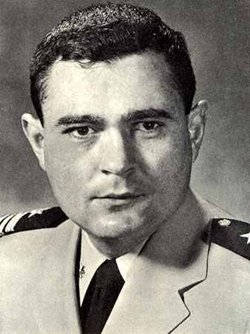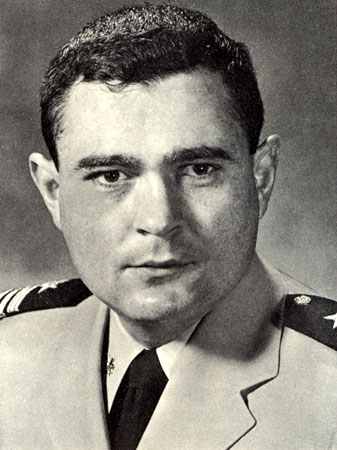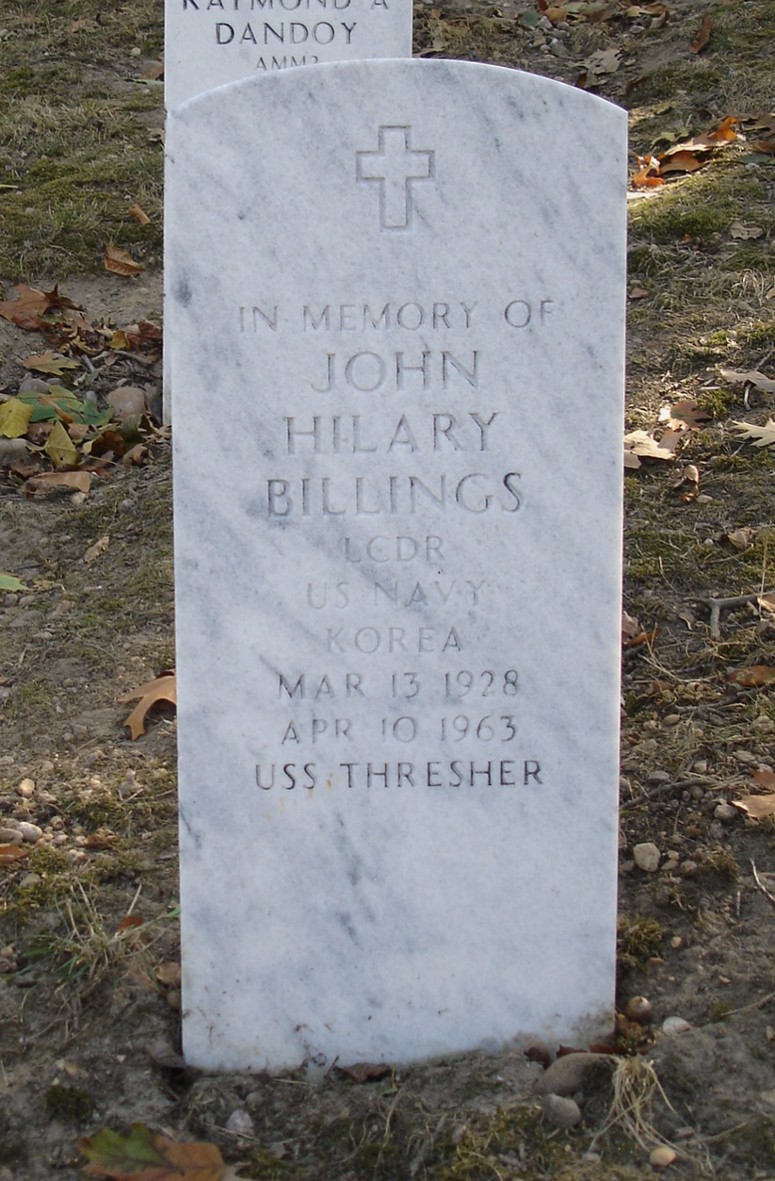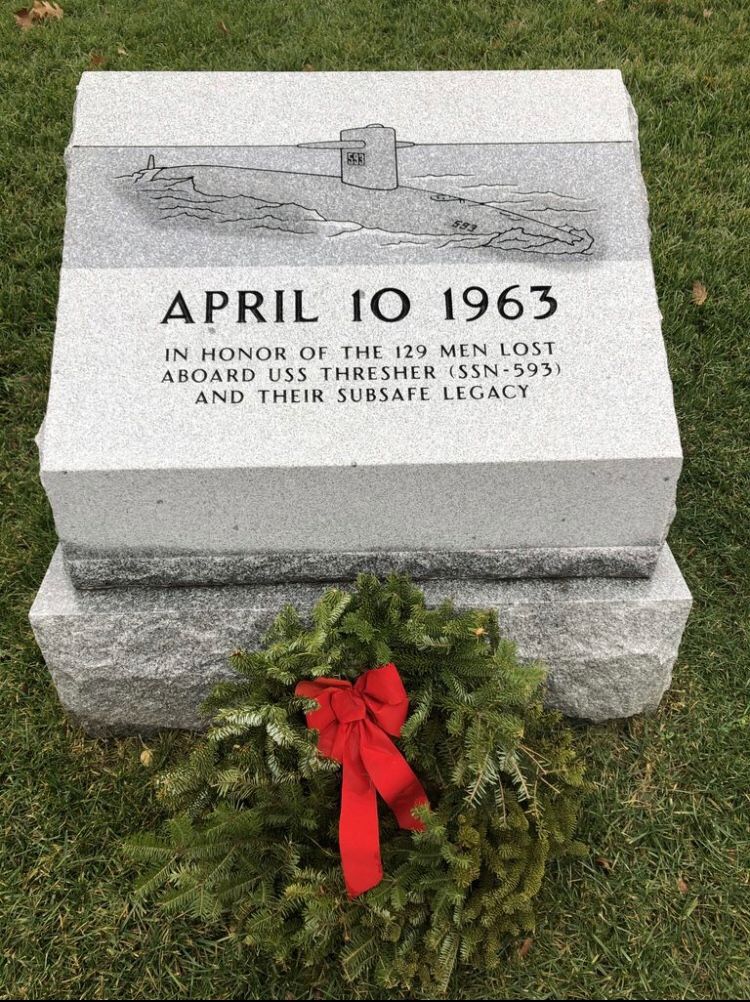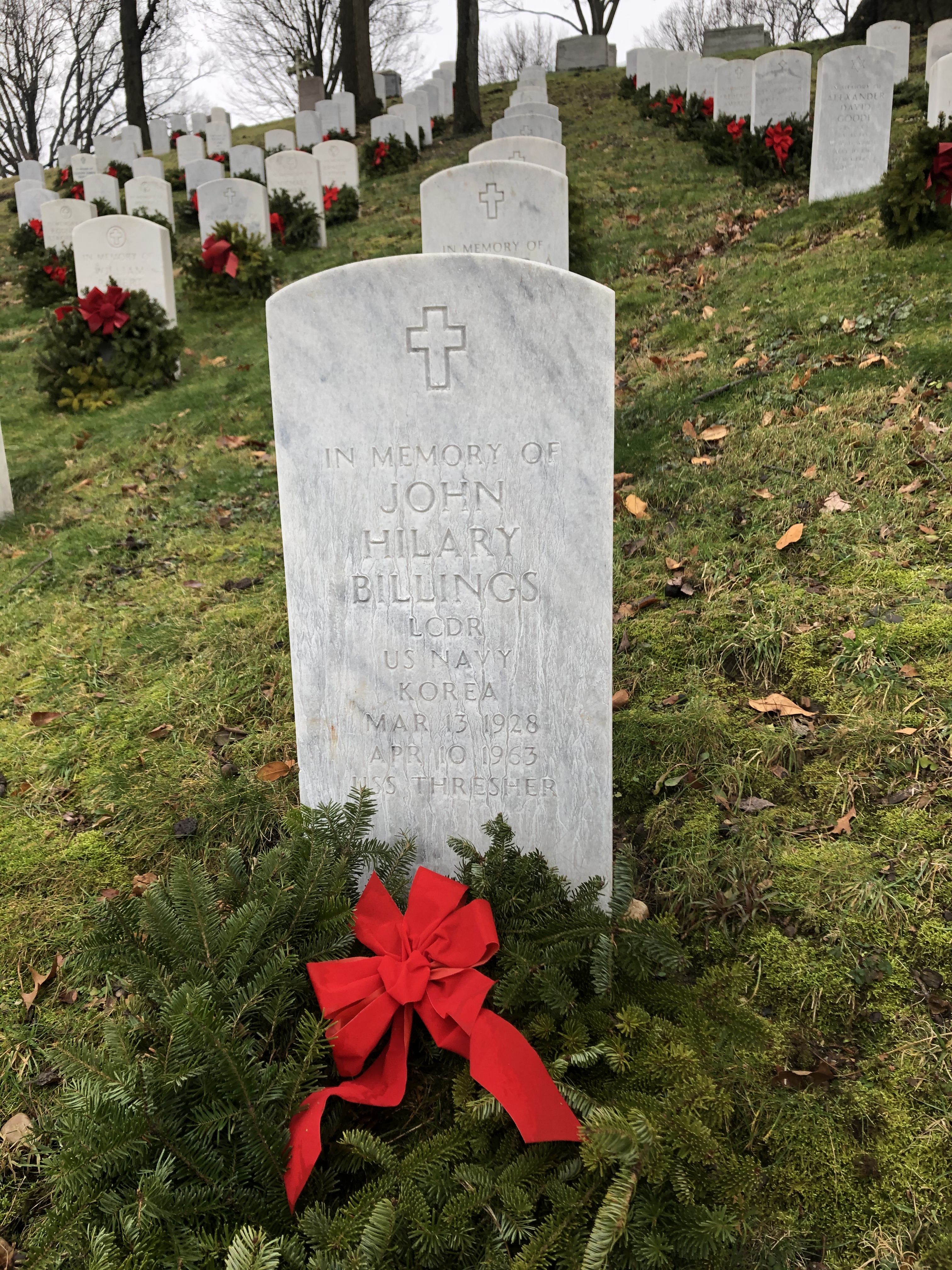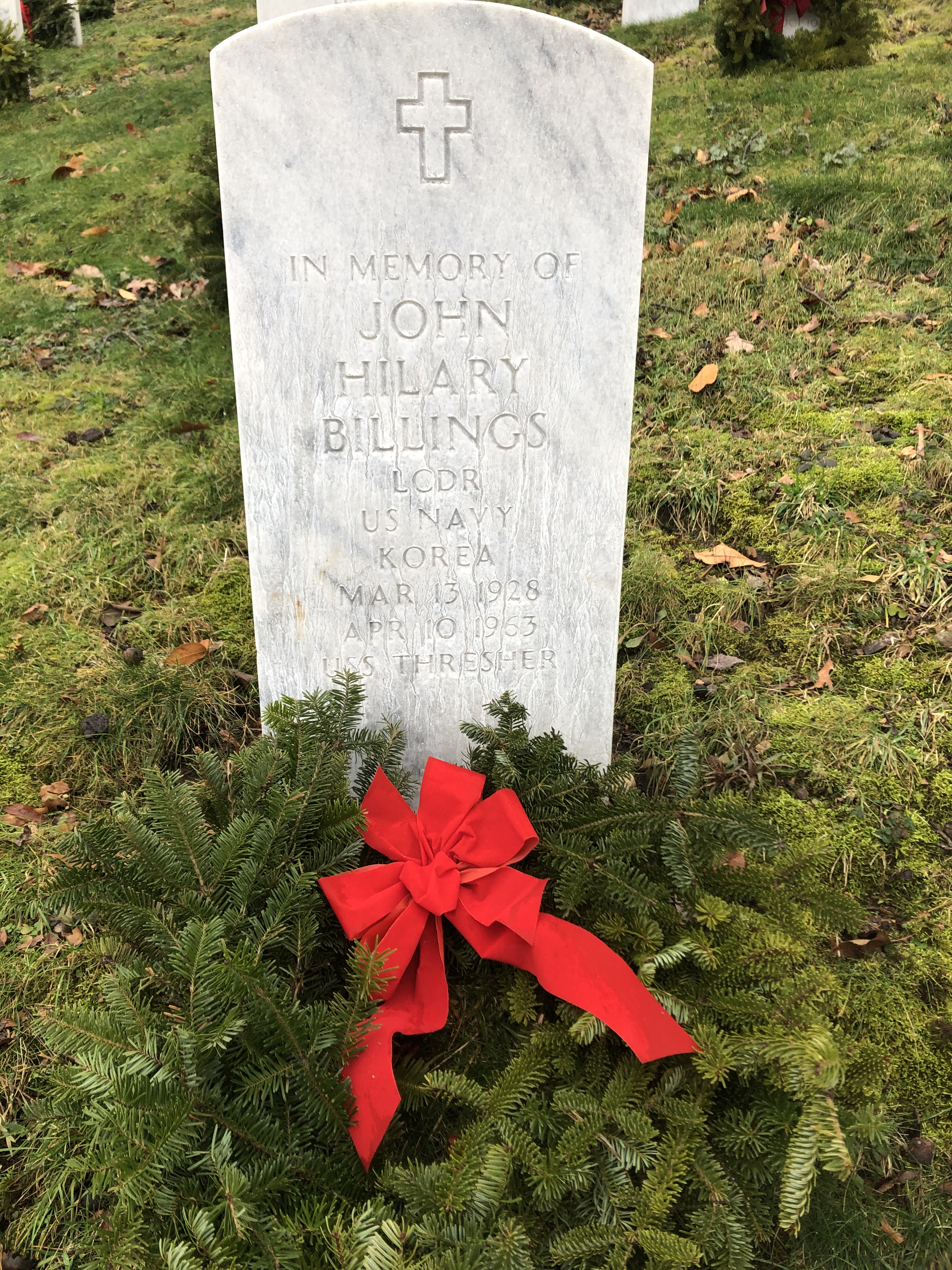Birth Date March 13, 1928
From Jamaica, New York
Decorations
Submarine USS Thresher (SSN-593)
Loss Date April 10, 1963
Location Approximately 300 miles off the coast of New England
Circumstances Most likely cause of the sinking was a failure in either a pipe, a pipe valve, or a hull weld, causing flooding near the engine room
On 9 April 1963, after the completion of this work, Thresher, now commanded by Lieutenant Commander John Wesley Harvey, began post-overhaul trials. Accompanied by the submarine rescue ship Skylark, she sailed to an area some 190 nmi (220 mi; 350 km) east of Cape Cod, Massachusetts, and on the morning of 10 April started deep-diving tests. As Thresher neared her test depth, Skylark received garbled communications over underwater telephone indicating "... minor difficulties, have positive up-angle, attempting to blow."[2][3][4] When Skylark received no further communication, surface observers gradually realized Thresher had sunk. Publicly it took some days to announce that all 129 officers, crewmen, and military and civilian technicians aboard were presumed dead.
After an extensive underwater search using the bathyscaphe Trieste, oceanographic ship Mizar and other ships, Thresher's remains were located on the sea floor, some 8,400 ft (2,600 m) below the surface, in six major sections.[5] The majority of the debris had spread over an area of about 134,000 m2 (160,000 sq yd). The major sections were the sail, sonar dome, bow section, engineering spaces section, operations spaces section, and the stern planes.
Deep sea photography, recovered artifacts, and an evaluation of her design and operational history permitted a Court of Inquiry to conclude Thresher had probably suffered the failure of a joint in a salt water piping system, which relied heavily on silver brazing instead of welding; earlier tests using ultrasound equipment found potential problems with about 14% of the tested brazed joints, most of which were determined not to pose a risk significant enough to require a repair. High-pressure water spraying from a broken pipe joint may have shorted out one of the many electrical panels, which in turn caused a shutdown ("scram") of the reactor, with a subsequent loss of propulsion. The inability to blow the ballast tanks was later attributed to excessive moisture in the ship's high-pressure air flasks, which froze and plugged the flasks' flowpaths while passing through the valves. This was later simulated in dock-side tests on Thresher's sister ship, Tinosa. During a test to simulate blowing ballast at or near test depth, ice formed on strainers installed in valves; the flow of air lasted only a few seconds. Air driers were later retrofitted to the high pressure air compressors, beginning with Tinosa, to permit the emergency blow system to operate properly.
Unlike diesel submarines, nuclear submarines rely on speed and deck angle rather than deballasting to surface; they are "driven" at an angle towards the surface. Ballast tanks were almost never blown at depth, and to do so could cause the ship to rocket to the surface out of control. Normal procedure was to drive the ship to periscope depth, raise the periscope to verify the area was clear, then blow the tanks and surface the ship.
At the time, reactor-plant operating procedures precluded a rapid reactor restart following a scram, or even the ability to use steam remaining in the secondary system to "drive" the ship to the surface. After a scram, standard procedure was to isolate the main steam system, cutting off the flow of steam to the turbines providing propulsion and electricity. This was done to prevent an over-rapid cool-down of the reactor. Thresher's Reactor Control Officer, Lieutenant Raymond McCoole, was not at his station in the maneuvering room, or indeed on the ship, during the fatal dive. McCoole was at home caring for his wife who had been injured in a household accident—he had been all but ordered ashore by a sympathetic Commander Harvey. McCoole's trainee, Jim Henry, fresh from nuclear power school, probably followed standard operating procedures and gave the order to isolate the steam system after the scram, even though Thresher was at or slightly below her maximum depth and was taking on water. Once closed, the large steam system isolation valves could not be reopened quickly. Reflecting on the situation in later life, McCoole was sure he would have delayed shutting the valves, thus allowing the ship to "answer bells" and drive herself to the surface, despite the flooding in the engineering spaces. Admiral Rickover later changed the procedure, allowing steam to be withdrawn from the secondary system in limited quantities for several minutes following a scram.
In a dockside simulation of flooding in the engine room, held before Thresher sailed, it took the watch in charge 20 minutes to isolate a simulated leak in the auxiliary seawater system. At test depth, taking on water, and with the reactor shut down, Thresher would not have had 20 minutes to recover. Even after isolating a short-circuit in the reactor controls it would have taken nearly 10 minutes to restart the plant.
Thresher likely imploded at a depth of 1,300–2,000 ft (400–610 m).
The Navy has periodically monitored the environmental conditions of the site since the sinking and has reported the results in an annual public report on environmental monitoring for U.S. Naval nuclear-powered ships. These reports provide specifics on the environmental sampling of sediment, water, and marine life which were taken to ascertain whether Thresher's nuclear reactor has had a significant effect on the deep ocean environment. The reports also explain the methodology for conducting deep sea monitoring from both surface vessels and submersibles. The monitoring data confirms that there has been no significant effect on the environment. Nuclear fuel in the submarine remains intact.
According to newly declassified information, the Navy sent Commander (Dr.) Robert Ballard, the oceanographer credited with locating the wreck of RMS Titanic, on a secret mission to map and collect visual data on both Thresher and Scorpion wrecks.[6] The Navy used Ballard's search for Titanic as a screen to hide the mission. Ballard approached the Navy in 1982 for funding to find Titanic with his new deep-diving robot submersible. The Navy saw the opportunity and granted him the money on the condition he first inspect the two submarine wrecks. Ballard's robotic survey discovered that Thresher had sunk so deep it imploded, turning into thousands of pieces. The only recoverable piece was a foot of marled pipe.[7] His 1985 search for Scorpion, which was thought to be a victim of a Soviet attack, revealed such a large debris field that it looked "as though it had been put through a shredding machine." Once the two wrecks had been visited, and the radioactive threat from both was established as small, Ballard was able to search for Titanic. Due to dwindling funds, he had just 12 days to do so, but he used the same debris-field search techniques he had used for the two subs, which worked, and Titanic was found.[8]
U.S. submarine classes are generally known by the hull number of the lead ship of the class–for instance, Los Angeles-class boats are called "688s" because the hull number of USS Los Angeles was SSN-688. The Thresher-class boats should thus be called "593s", but since Thresher's sinking they have been referred to as "594s" (Permit class).
Birth Date March 13, 1928
From Jamaica, New York
Decorations
Submarine USS Thresher (SSN-593)
Loss Date April 10, 1963
Location Approximately 300 miles off the coast of New England
Circumstances Most likely cause of the sinking was a failure in either a pipe, a pipe valve, or a hull weld, causing flooding near the engine room
On 9 April 1963, after the completion of this work, Thresher, now commanded by Lieutenant Commander John Wesley Harvey, began post-overhaul trials. Accompanied by the submarine rescue ship Skylark, she sailed to an area some 190 nmi (220 mi; 350 km) east of Cape Cod, Massachusetts, and on the morning of 10 April started deep-diving tests. As Thresher neared her test depth, Skylark received garbled communications over underwater telephone indicating "... minor difficulties, have positive up-angle, attempting to blow."[2][3][4] When Skylark received no further communication, surface observers gradually realized Thresher had sunk. Publicly it took some days to announce that all 129 officers, crewmen, and military and civilian technicians aboard were presumed dead.
After an extensive underwater search using the bathyscaphe Trieste, oceanographic ship Mizar and other ships, Thresher's remains were located on the sea floor, some 8,400 ft (2,600 m) below the surface, in six major sections.[5] The majority of the debris had spread over an area of about 134,000 m2 (160,000 sq yd). The major sections were the sail, sonar dome, bow section, engineering spaces section, operations spaces section, and the stern planes.
Deep sea photography, recovered artifacts, and an evaluation of her design and operational history permitted a Court of Inquiry to conclude Thresher had probably suffered the failure of a joint in a salt water piping system, which relied heavily on silver brazing instead of welding; earlier tests using ultrasound equipment found potential problems with about 14% of the tested brazed joints, most of which were determined not to pose a risk significant enough to require a repair. High-pressure water spraying from a broken pipe joint may have shorted out one of the many electrical panels, which in turn caused a shutdown ("scram") of the reactor, with a subsequent loss of propulsion. The inability to blow the ballast tanks was later attributed to excessive moisture in the ship's high-pressure air flasks, which froze and plugged the flasks' flowpaths while passing through the valves. This was later simulated in dock-side tests on Thresher's sister ship, Tinosa. During a test to simulate blowing ballast at or near test depth, ice formed on strainers installed in valves; the flow of air lasted only a few seconds. Air driers were later retrofitted to the high pressure air compressors, beginning with Tinosa, to permit the emergency blow system to operate properly.
Unlike diesel submarines, nuclear submarines rely on speed and deck angle rather than deballasting to surface; they are "driven" at an angle towards the surface. Ballast tanks were almost never blown at depth, and to do so could cause the ship to rocket to the surface out of control. Normal procedure was to drive the ship to periscope depth, raise the periscope to verify the area was clear, then blow the tanks and surface the ship.
At the time, reactor-plant operating procedures precluded a rapid reactor restart following a scram, or even the ability to use steam remaining in the secondary system to "drive" the ship to the surface. After a scram, standard procedure was to isolate the main steam system, cutting off the flow of steam to the turbines providing propulsion and electricity. This was done to prevent an over-rapid cool-down of the reactor. Thresher's Reactor Control Officer, Lieutenant Raymond McCoole, was not at his station in the maneuvering room, or indeed on the ship, during the fatal dive. McCoole was at home caring for his wife who had been injured in a household accident—he had been all but ordered ashore by a sympathetic Commander Harvey. McCoole's trainee, Jim Henry, fresh from nuclear power school, probably followed standard operating procedures and gave the order to isolate the steam system after the scram, even though Thresher was at or slightly below her maximum depth and was taking on water. Once closed, the large steam system isolation valves could not be reopened quickly. Reflecting on the situation in later life, McCoole was sure he would have delayed shutting the valves, thus allowing the ship to "answer bells" and drive herself to the surface, despite the flooding in the engineering spaces. Admiral Rickover later changed the procedure, allowing steam to be withdrawn from the secondary system in limited quantities for several minutes following a scram.
In a dockside simulation of flooding in the engine room, held before Thresher sailed, it took the watch in charge 20 minutes to isolate a simulated leak in the auxiliary seawater system. At test depth, taking on water, and with the reactor shut down, Thresher would not have had 20 minutes to recover. Even after isolating a short-circuit in the reactor controls it would have taken nearly 10 minutes to restart the plant.
Thresher likely imploded at a depth of 1,300–2,000 ft (400–610 m).
The Navy has periodically monitored the environmental conditions of the site since the sinking and has reported the results in an annual public report on environmental monitoring for U.S. Naval nuclear-powered ships. These reports provide specifics on the environmental sampling of sediment, water, and marine life which were taken to ascertain whether Thresher's nuclear reactor has had a significant effect on the deep ocean environment. The reports also explain the methodology for conducting deep sea monitoring from both surface vessels and submersibles. The monitoring data confirms that there has been no significant effect on the environment. Nuclear fuel in the submarine remains intact.
According to newly declassified information, the Navy sent Commander (Dr.) Robert Ballard, the oceanographer credited with locating the wreck of RMS Titanic, on a secret mission to map and collect visual data on both Thresher and Scorpion wrecks.[6] The Navy used Ballard's search for Titanic as a screen to hide the mission. Ballard approached the Navy in 1982 for funding to find Titanic with his new deep-diving robot submersible. The Navy saw the opportunity and granted him the money on the condition he first inspect the two submarine wrecks. Ballard's robotic survey discovered that Thresher had sunk so deep it imploded, turning into thousands of pieces. The only recoverable piece was a foot of marled pipe.[7] His 1985 search for Scorpion, which was thought to be a victim of a Soviet attack, revealed such a large debris field that it looked "as though it had been put through a shredding machine." Once the two wrecks had been visited, and the radioactive threat from both was established as small, Ballard was able to search for Titanic. Due to dwindling funds, he had just 12 days to do so, but he used the same debris-field search techniques he had used for the two subs, which worked, and Titanic was found.[8]
U.S. submarine classes are generally known by the hull number of the lead ship of the class–for instance, Los Angeles-class boats are called "688s" because the hull number of USS Los Angeles was SSN-688. The Thresher-class boats should thus be called "593s", but since Thresher's sinking they have been referred to as "594s" (Permit class).
Sponsored by Ancestry
Advertisement
Records on Ancestry
Advertisement
